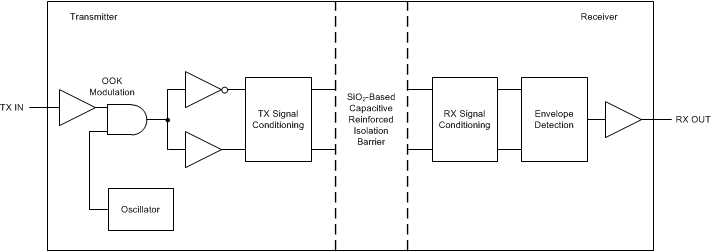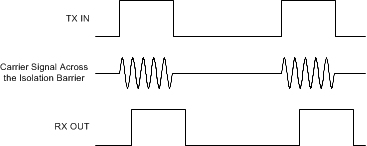ZHCSIE0A June 2018 – October 2018 ISO224
PRODUCTION DATA.
- 1 特性
- 2 应用
- 3 说明
- 4 修订历史记录
- 5 器件比较表
- 6 Pin Configuration and Functions
-
7 Specifications
- 7.1 Absolute Maximum Ratings
- 7.2 ESD Ratings
- 7.3 Recommended Operating Conditions
- 7.4 Thermal Information
- 7.5 Power Ratings
- 7.6 Insulation Specifications
- 7.7 Safety-Related Certifications
- 7.8 Safety Limiting Values
- 7.9 Electrical Characteristics
- 7.10 Switching Characteristics
- 7.11 Insulation Characteristics Curves
- 7.12 Typical Characteristics
- 8 Detailed Description
- 9 Application and Implementation
- 10Power Supply Recommendations
- 11Layout
- 12器件和文档支持
- 13机械、封装和可订购信息
8.3.3 Isolation Channel Signal Transmission
The ISO224 uses an on-off keying (OOK) modulation scheme to transmit the modulator output bitstream across the SiO2-based isolation barrier. As shown in Figure 44, the transmitter modulates the bitstream at TX IN with an internally-generated, high-frequency carrier across the isolation barrier to represent a digital one and does not send a signal to represent the digital zero. The nominal frequency of the carrier used inside the ISO224 is 480 MHz.
The receiver demodulates the signal after advanced signal conditioning and produces the output. The ISO224 also incorporates advanced circuit techniques to maximize the CMTI performance and minimize the radiated emissions caused by the high-frequency carrier and IO buffer switching.
 Figure 44. Block Diagram of an Isolation Channel
Figure 44. Block Diagram of an Isolation Channel Figure 45 shows the concept of the OOK scheme.
 Figure 45. OOK-Based Modulation Scheme
Figure 45. OOK-Based Modulation Scheme